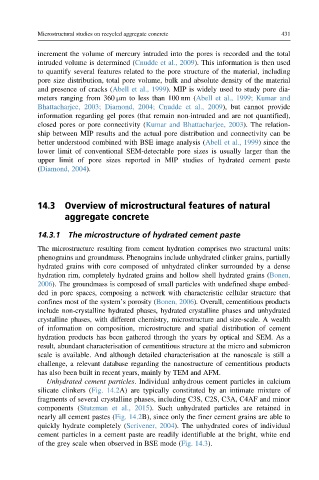Page 481 - New Trends in Eco efficient and Recycled Concrete
P. 481
Microstructural studies on recycled aggregate concrete 431
increment the volume of mercury intruded into the pores is recorded and the total
intruded volume is determined (Cnudde et al., 2009). This information is then used
to quantify several features related to the pore structure of the material, including
pore size distribution, total pore volume, bulk and absolute density of the material
and presence of cracks (Abell et al., 1999). MIP is widely used to study pore dia-
meters ranging from 360 μm to less than 100 nm (Abell et al., 1999; Kumar and
Bhattacharjee, 2003; Diamond, 2004; Cnudde et al., 2009), but cannot provide
information regarding gel pores (that remain non-intruded and are not quantified),
closed pores or pore connectivity (Kumar and Bhattacharjee, 2003). The relation-
ship between MIP results and the actual pore distribution and connectivity can be
better understood combined with BSE image analysis (Abell et al., 1999) since the
lower limit of conventional SEM-detectable pore sizes is usually larger than the
upper limit of pore sizes reported in MIP studies of hydrated cement paste
(Diamond, 2004).
14.3 Overview of microstructural features of natural
aggregate concrete
14.3.1 The microstructure of hydrated cement paste
The microstructure resulting from cement hydration comprises two structural units:
phenograins and groundmass. Phenograins include unhydrated clinker grains, partially
hydrated grains with core composed of unhydrated clinker surrounded by a dense
hydration rim, completely hydrated grains and hollow shell hydrated grains (Bonen,
2006). The groundmass is composed of small particles with undefined shape embed-
ded in pore spaces, composing a network with characteristic cellular structure that
confines most of the system’s porosity (Bonen, 2006). Overall, cementitious products
include non-crystalline hydrated phases, hydrated crystalline phases and unhydrated
crystalline phases, with different chemistry, microstructure and size-scale. A wealth
of information on composition, microstructure and spatial distribution of cement
hydration products has been gathered through the years by optical and SEM. As a
result, abundant characterisation of cementitious structure at the micro and submicron
scale is available. And although detailed characterisation at the nanoscale is still a
challenge, a relevant database regarding the nanostructure of cementitious products
has also been built in recent years, mainly by TEM and AFM.
Unhydrated cement particles. Individual anhydrous cement particles in calcium
silicate clinkers (Fig. 14.2A) are typically constituted by an intimate mixture of
fragments of several crystalline phases, including C3S, C2S, C3A, C4AF and minor
components (Stutzman et al., 2015). Such unhydrated particles are retained in
nearly all cement pastes (Fig. 14.2B), since only the finer cement grains are able to
quickly hydrate completely (Scrivener, 2004). The unhydrated cores of individual
cement particles in a cement paste are readily identifiable at the bright, white end
of the grey scale when observed in BSE mode (Fig. 14.3).

